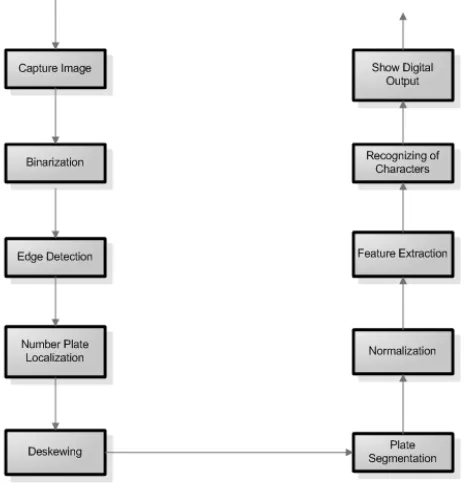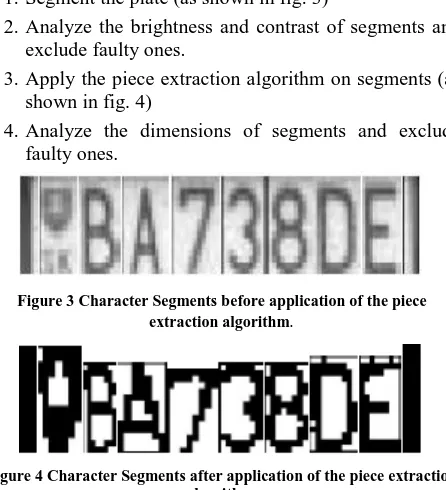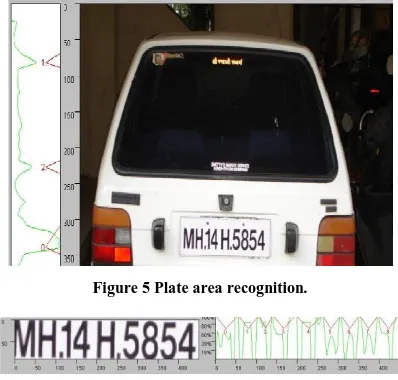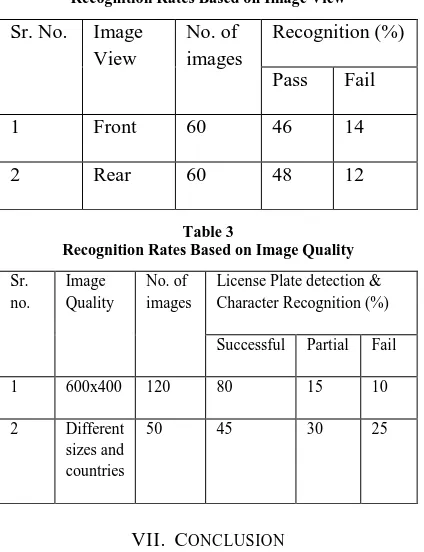International Journal of Emerging Technology and Advanced Engineering
Website: www.ijetae.com (ISSN 2250-2459,ISO 9001:2008 Certified Journal, Volume 3, Issue 6, June 2013)
202
An Approach for Automatic Detection of Vehicle License Plate
and Character Recognition Using Classification Algorithm
Pawan Wawage
1, Shraddha Oza
2Dept of Computer Engineering, MIT, Pune – 38, India
Abstract – Automatic Identification of Vehicle License Plate is a real time embedded system which identifies the characters directly from the image of the vehicle license plate. Since number plate guidelines are not strictly practiced everywhere, it often becomes difficult to correctly identify the non-standard number plate characters. This paper proposes a vehicle number plate identification system, which extracts the characters features of a plate from a captured image by a digital camera. This paper deals with computing techniques from the field of Artificial Intelligence, machine vision, and neural networks in construction of an Automatic System for Identification of Vehicle License Plate and Character Recognition.
The system consists of the following standard modules: 1. Edge Detection
2. Selection of probable Band 3. Number Plate Localization 4. Skew detection and de-skewing 5. Character Segmentation 6. Character Recognition
Keywords – ANPR, Artificial Intelligence, Neural Networks, Optical Character Recognition.
I. INTRODUCTION
With the rapid growth in the number of vehicle, there is need to improve the existing systems for identification of vehicle. An automated system that can identify vehicle is in demand in order to reduce the dependency on labour. The license plate for vehicles has white and black characters. Massive integration of information technologies into all aspects of modern life caused demand for processing vehicles as conceptual resources in information systems. Because a standalone information system without any data has no sense, there was also a need to transform information about vehicles between the reality and information systems. This can be achieved by a human agent, or by special intelligent equipment which is be able to recognize vehicles by their number plates in a real environment and reflect it into conceptual resources.
The design of Number Plate Recognition systems is a field of research in artificial intelligence, machine vision, pattern recognition and neural networks.
The steps involved in number plate recognition systems include plate localization which involves the recognition and isolation of the number plates in a vehicle image captured by the cameras. The system assumes that number plate is a rectangular area containing a number of dark characters on a white background. In number plate recognition, one of the most difficult tasks is to locate the number plate, which could be anywhere in the image. This task is more challenging if the illumination of the image varies from plate to another.
[image:1.612.328.560.438.681.2]Basically, the Number Plate Recognition operation consists in capturing, recognizing and storing information such as images, plate numbers and location on a database for online verification or posterior analysis. The approach presented in this paper is to extract the region of the number plate from images taken from indoor parking lots, which suffer from various real world problems like lighting condition, luminance, weather conditions etc.
International Journal of Emerging Technology and Advanced Engineering
Website: www.ijetae.com (ISSN 2250-2459,ISO 9001:2008 Certified Journal, Volume 3, Issue 6, June 2013)
203
This system can be fine tuned on the basis of parameters, as these parameters can be country-specific. So the problem can be narrowed down for application in a particular country. For example, in India black color for number printing on white background is used for private vehicles and yellow background is used for commercial vehicles, as per the traffic norms.A.Existing Systems
ANPR systems have been implemented in many countries. Strict implementation of license plate standards in these countries has helped the early development of ANPR systems. These systems use standard features of the license plates such as: dimensions of plate, borders of the plate, color and font of characters, etc. help to localize the number plate and identify the vehicle license number of the vehicle.
In India, number plate standards are rarely followed (in terms of font type and size). Wide variations can be found in terms of font types, script, size, placement, and color of the number plates. In few cases, other unwanted decorations are present on the number plate. Also, unlike other countries, no special features are available on Indian number plates to ease their recognition process. The general format for the license plate is two letters (for state code) followed by district code, then a four digit code specific to a particular vehicle. Hence, currently only manual recording systems are used and ANPR has not been commercially implemented in India.
II. NUMBER PLATE AREA LOCALIZATION
After capturing the front or rear view of the vehicle, the first step is to detect the exact area of the number plate from the captured image. Let us define the number plate as a “rectangular area with increased occurrence of horizontal and vertical edges”. The high density of horizontal and vertical edges on a small area is in many cases caused by contrast characters of a number plate, but not in every case. This process can sometimes detect a wrong area that does not correspond to a number plate. Because of this, we often detect several candidates for the plate by different algorithms.
In general, the captured snapshot can contain several number plate candidates. Because of this, the detection algorithm always clips several bands, and several plates from each band. There is a predefined value for number of candidates, which are detected by analysis of projections (by default this value is equal to nine).
There are several heuristics, which are used to determine the cost of selected candidates according to their properties. These heuristics have been chosen on ad-hoc basis during the practical experimentations. The recognition logic sorts candidates according to their cost from the most suitable to the least suitable. Then, the most suitable candidate is examined by a deeper heuristic analysis. The deeper analysis definitely accepts, or rejects the candidate. As there is a need to analyze individual characters, this type of analysis consumes big amount of processor time.
The basic concept of analysis can be illustrated by the following steps:
1. Detect available number plate inputs.
2. Sort them according to their cost which is based on heuristics.
3. Cut the first plate from the list with the best cost.
4. Segment the number plate.
5. Analyze it by a deeper analysis which is time consuming.
6. If the deeper analysis rejects the plate, return to step 3.
III. NUMBER PLATE SEGMENTATION
After the detection of number plate area, next step is segmentation of the plate. The number plate can be segmented based on horizontal or vertical projection. We can use the method of horizontal projection for segmentation, or one of the more sophisticated methods, such as segmentation using neural networks. If we assume only one row plate, the segmentation is the process of finding horizontal boundaries between characters. The segmented area of the plate can contain redundant space and other undesirable elements besides the characters. Since the “segment” has been processed by an adaptive thresholding filter, it contains only black and white pixels. The neighboring pixels are grouped together into larger pieces, and one of them is a character. Our goal is to divide the segment into several pieces, and identify only one piece representing the regular character.
International Journal of Emerging Technology and Advanced Engineering
Website: www.ijetae.com (ISSN 2250-2459,ISO 9001:2008 Certified Journal, Volume 3, Issue 6, June 2013)
[image:3.612.82.264.141.227.2]204
Figure 2 Horizontal segment of the number plate contains severalpieces of neighboring pixels.
IV. FEATURE EXTRACTION
Before extracting feature descriptors from a bitmap representation of a character, it is necessary to normalize it into unified dimensions. We define the term “resampling” as the process of changing dimensions of the character. As original dimensions of un-normalized characters are usually higher than the normalized ones, the characters are in most cases downsampled. When we say downsample, we reduce information contained in the processed image.
There are several methods of resampling, such as the pixel re-size, bilinear interpolation, or the weighted-average resampling. We cannot determine which method is the best in general, because the successfulness of a particular method depends on many factors. For example, usage of the weighted-average downsampling in combination with of detection of character edges is not a good solution, because this type of downsampling does not preserve sharp edges. Because of this, the problem of character resampling is closely associated with the problem of feature extraction. To recognize a character from a bitmap representation, there is a need to extract feature descriptor of such bitmap. As the extraction method significantly affects the quality of whole OCR process, it is very important to extract features which will be invariant towards the various light conditions, used font type and deformation of characters caused by a skew of the image.
The description of normalized character is based on its external characteristics because we deal only with properties such as character shape. Then, the vector of descriptors includes characteristics such as number of lines, bays, lakes, the amount of horizontal, vertical, or diagonal edges etc. The feature extraction is a process of transformation of data from a bitmap representation into a form of descriptors, which are more suitable for computers. If we associate similar instances of the same character into the classes, then the descriptors of characters from the same class should be geometrically closed to each other in the vector space. This is the basic assumption for successfulness of the pattern recognition process.
1.Feature Extraction Process
At first, we have to embed the character bitmap f(x, y)
into a bigger bitmap with white padding to ensure a proper behavior of the feature extraction algorithm. Let the padding be one pixel wide. Then, dimensions of the embedding bitmap will be w+2 and h+2. The embedding bitmap f’(x, y) is then defined as:
1 1 0 0 ) 1 , 1 ( 1 1 0 0 1 ) , ( ' h y w x y x if y x f h y w x y x if y x fWhere w and h are dimensions of character bitmap before embedding. Color of the padding is white (value of 1). The coordinates of pixels are shifted one pixel towards the original position.
The structure of vector of output descriptors is illustrated by the pattern below:
X = (h0@r0, h1@r1,..., hn-1@r0, h1@r1,..., h n-1@r1, h0@r p-1, h1@rp-1,..., hn-1@r p-1)
The notation hj@ri means “number occurrences of an edge represented by the matrix hj in the region ri”. We compute the position k of the hj@ri in the vector x as k =
i.n + j, where n is the number of different edge types (and also the number of corresponding matrices).
The following algorithm demonstrates the computation of the vector of descriptors x:
zerosize vector x
for each region ri, where i
0
,
…
,
1
do beginfor each pixel [
x
, y] in region
r
ido
begin
for each matrix hj, where j0,…,n - 1 do begin
if hj =
)
1
,
1
(
'
)
1
,
(
'
)
,
1
(
'
)
,
(
'
y
x
f
y
x
f
y
x
f
y
x
f
then beginlet k = i.n +j let xk = xk+1
end
end
end
International Journal of Emerging Technology and Advanced Engineering
Website: www.ijetae.com (ISSN 2250-2459,ISO 9001:2008 Certified Journal, Volume 3, Issue 6, June 2013)
205
V. NORMALIZATION OF CHARACTERS
The first step in the normalization process is the normalization of a brightness and contrast of a processed image segment. The character contained in the image segment must be then resized to uniform dimensions in the second step. The Feature Extraction algorithm extracts appropriate descriptors from the normalized characters in the third step. The brightness and contrast characteristics of segmented characters are varying due to different light conditions during the image is captured. Because of this, it is necessary to normalize them. There are many different ways, but this section describes the three most used: histogram normalization, global and adaptive thresholding.
Through the histogram normalization, the intensities of character segments are redistributed on the histogram to obtain the normalized statistics. The areas of lower contrast will gain a higher contrast without affecting the global characteristics of image. Techniques of global and adaptive thresholding are used to obtain monochrome representations of processed character segments. The monochrome (black & white) representation of image is more appropriate for analysis, because it defines clear boundaries of contained character.
1. Adaptive Scheduling
The number plate can be sometimes partially shadowed or non-uniformly illuminated. This is most frequent reason why the global thresholding fail. The adaptive thresholding solves several disadvantages of the global thresholding, because it computes threshold value for each pixel separately using its local neighborhood.
2. Chow and Kaneko approach
There are two approaches for finding the threshold: first is the Chow and Kaneko approach, and second is the local thresholding. Both the methods assume those smaller rectangular regions are more likely to have approximately uniform illumination, more suitable for thresholding. The image is divided into uniform rectangular areas with size of (m x n) pixels. The local histogram is computed for each such area and a local threshold is determined. The threshold of concrete point is then computed by interpolating the results of the sub images.
3. Character Recognition and Syntax Checking
The segmentation algorithm can sometimes detect redundant elements, which do not correspond to proper character. The shape of these elements after normalization is often similar to the shape of characters.
Because of this, these elements are not reliably separable by traditional OCR methods, although they vary in size as well as in contrast, brightness or hue. Since the feature extraction methods do not consider these properties, there is a need to use additional heuristics properties. Elements with considerably different properties are treated as invalid and excluded from the recognition process.
The analysis consists of two phases: the first phase deals with statistics of brightness and contrast of segmented characters. Characters are then normalized and processed by the piece extraction algorithm. Since the piece extraction and normalization of brightness disturbs statistical properties of segmented characters, it is necessary to proceed the first phase of analysis before the application of the piece extraction algorithm.
In addition, the heights of detected segments are same for all characters. Because of this, there is a need to proceed the analysis of dimensions after application of the piece extraction algorithm. The piece extraction algorithm strips off white padding, which surrounds the character.
Respecting the constraints above, the sequence of steps can be assembled as given below:
1. Segment the plate (as shown in fig. 3)
2. Analyze the brightness and contrast of segments and exclude faulty ones.
3. Apply the piece extraction algorithm on segments (as shown in fig. 4)
[image:4.612.333.556.398.643.2]4. Analyze the dimensions of segments and exclude faulty ones.
Figure 3 Character Segments before application of the piece extraction algorithm.
Figure 4 Character Segments after application of the piece extraction algorithm.
International Journal of Emerging Technology and Advanced Engineering
Website: www.ijetae.com (ISSN 2250-2459,ISO 9001:2008 Certified Journal, Volume 3, Issue 6, June 2013)
206
If we have country specific rules for the plate, we can evaluate the validity of that plate towards these rules. Automatic syntax-based correction of plate numbers can increase recognition ability of the ANPR system.For example, if the recognition software is confused between characters “8” and “B”, the final decision can be made according to the syntactical pattern. If the pattern allows only digits for that position, the character “8” will be used rather the character “B”. this the most critical stage of the ANPR system. Direct template matching can be used to identify characters. However, this method yields a very low success rate for font variations which are commonly found in Indian number plates. Artificial Neural Networks like BPNNs can be used to classify the characters. However, they do not provide hardware and time optimization. Therefore statistical feature extraction is used. In this method, initially the character is divided into twelve equal parts and fourteen features are extracted from each part. The features used are binary edges (2x2) of fourteen types. The feature vector thus formed is compared with feature vector of all the stored templates and the maximum value of correlation is calculated to give the right character.
VI. RESULTS
[image:5.612.338.550.108.652.2]Figure (5, 6, 7, 8, 9) below shows the output of the proposed system after completion of each step. After the character segmentation process the vehicle license number will be identified by recognizing each character from the segmented plate.
Figure 5 Plate area recognition.
Figure 6 Plate detection
Figure 7 Plate Skew detection
Figure 8 Band Clipping and Plate Clipping
Figure 9 Character Segmentation Table 1
Recognition Rates of the system No. of
images
No. of characters
Weighted score
Clear images
62 425 88.76
Blurred images
41 324 50.43
Skewed images
34 264 54.26
Average images
[image:5.612.68.267.491.681.2]International Journal of Emerging Technology and Advanced Engineering
Website: www.ijetae.com (ISSN 2250-2459,ISO 9001:2008 Certified Journal, Volume 3, Issue 6, June 2013)
207
Table 2Recognition Rates Based on Image View Sr. No. Image
View
No. of images
Recognition (%)
Pass Fail
1 Front 60 46 14
[image:6.612.64.276.150.426.2]2 Rear 60 48 12
Table 3
Recognition Rates Based on Image Quality
Sr. no.
Image Quality
No. of images
License Plate detection & Character Recognition (%)
Successful Partial Fail
1 600x400 120 80 15 10
2 Different
sizes and countries
50 45 30 25
VII. CONCLUSION
The system has been tested on static snapshots of vehicles, which has divided into several sets according to difficulties. Sets of blurry and skewed snapshots give worse recognition rates than a set of snapshots, which has been captured clearly.
The objective of the tests was not to find 100% recognizable set of snapshots, but to test the invariance of the algorithms on random snapshots systematically classified to the sets according to their properties
.
Currently there are certain restrictions on parameters like speed of the vehicle, script on the number plate, cleanliness of number plate, quality of captured image, skew in the image which can be aptly removed by enhancing the algorithm further.
REFERENCES
[1] Peter M. Roth, Martin K’ostinger, Paul Wohlhart, and Horst Bischof, Josef A. Birchbauer (2010): Automatic Detection and Reading of Dangerous Goods Plates, 2010 Seventh IEEE International Conference on Advanced Video and Signal Based Surveillance. [2] W. K. I. L. Wanniarachchi, D. U. J. Sonnadara and M. K.
Jayananda, (2007): License Plate Identification Based on Image Processing Techniques, Second International Conference on Industrial and Information Systems.
[3] Ping Dong Jie-hui Yang Jun-jun Dong, (2006): The Application and Development Perspective of Number Plate Automatic Recognition Technique, IEEE.
[4] Ankush Roy, Debarshi Patanjali Ghoshal, (2011): Number Plate Recognition for Use in Different Countries Using an Improved Segmentation, IEEE.
[5] Luis Salgado, Jose M. Mene’ndex, Enrique Rendnn and Narciso Garcia (1999): Automatic Car Plate Detection and Recognition through Intelligent Vision Engineering, IEEE.
[6] Prof. Thomas B. Fomby – “K-Nearest Neighbors Algorithm: Prediction and Classification” Department of Economics Southern Methodist University Dallas, TX 75275 February 2008
[7] Zhiyong Yan, Congfu Xu – “Combining KNN Algorithm and Other Classifiers”, Proc. 9th IEEE Int. Conf. on Cognitive Informatics (ICCI’10) ©2010 IEEE
[8] Muhammad Tahir Qadri, Muhammad Asif : Automatic Number Plate Recognition System for Vehicle Identification Using Optical Character Recognition, International Conference on Education Technology and Computer, IEEE 2009.
[9] B. Raveendran Pillai, Prot: (Dr). Sukesh Kumar. A: A Real-time system for the automatic identification of motorcycle - using Artificial Neural Networks Recognition, World Academy of Science, Engineering and Technology 9, 2005.
[10] Su-Hyun Lee,Young- Soo Seok and Eung-Joo Lee Department of information/Communication Eng.,TongMyong Univ.of Information Technology: Multi-National Integrated Car-License Plate Recognition System Using Geometrical Feature and Hybrid Pattern Vector.



